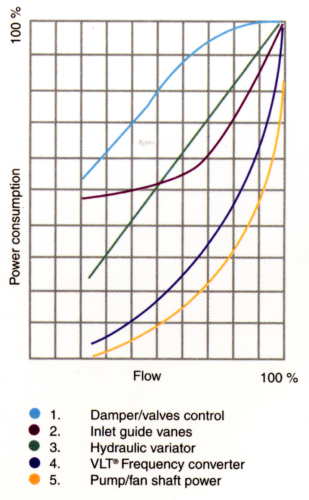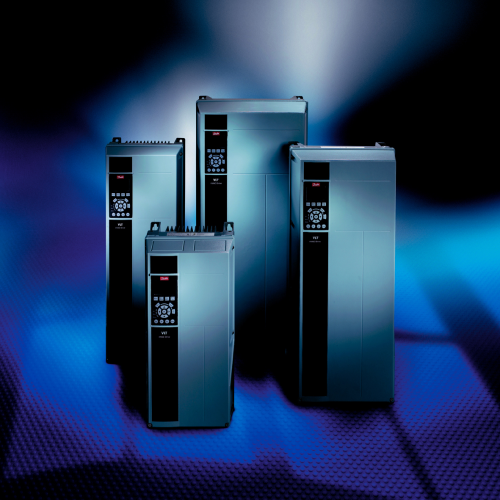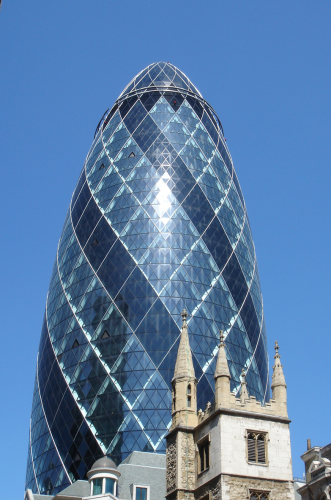


Energy savings in builds has now become so critical that it has even been enshrined in law by the new building regulations. That part concerning energy efficiency, Part L, is now ‘live’ and mandates a substantial improvement of between 23% and 28% in energy performance of non-domestic buildings.
While this sounds so draconian as to be unachievable, in many cases it is actually more than achievable because the air conditioning systems of modern buildings offer the greatest potential for energy savings. The fans, pumps, cooling towers and humidification systems of today's buildings comprise some 40% of that building's energy costs. Particularly where older HVAC systems are concerned there is invariably enormous scope for energy savings.
As has often been remarked, the UK does not have a climate; it has weather and very variable weather at that. Environmental conditions vary day to night, day to day and season to season over an extremely wide range and air conditioning systems are of necessity designed to cope with that. Unfortunately, when the majority of building's air-conditioning systems were designed and installed, energy efficiency was not a priority and systems were designed to meet the lowest installed cost. Despite the need for close building environmental control over wide ranging outdoor conditions, the control mechanisms employed were crude and simplistic. In variable air volume (VAV) systems, damper and vane control of air handling fans, throttling of chiller pumps and on-off control of many functions was the norm in matching the capacity of the system to the actual requirements of the building.
The systems being installed in modern buildings these days could not be more different. This revolution in efficient air conditioning systems is due to the development of the most improbable and complex device to touch all of our lives – the microprocessor. These min-computers in a single electronic chip have ushered in an age of superior Building Management Systems (BMS) linked via fieldbus networks such as BacNet, to a complex network of sensors and variable speed drives controlling the motors that drive the numerous fans and pumps that constitute a modern, efficient climate control system. The result is a much more stable, comfortable working environment, right through the year and even on the hottest days.
While the modern BMS has made an enormous contribution to overall control of the system and fieldbus networks have simplified connectivity throughout the building, the greatest contribution to energy efficiency has come from variable speed control of the fan and pump motors themselves.
This is where the largest consumption of energy takes place and where the need for efficiency is greatest. Considering the widely varying conditions under which a UK building climate control system is required to work, it is inevitable that all of the fans and pumps must by definition be oversized a great deal of the time. In point of fact, even under the most extreme operating conditions, the vast majority of systems are designed with what can only be described as a generous ‘service factor’ and seldom work beyond 75% capacity. At every stage of the design process, margins were built in to ensure no-one erred on the side of incapacity. Inefficient throttles and dampers were then employed pretty much all of the time to control a system more than fit for purpose.
The problem with this is that all of the fans and pumps employed in buildings are centrifugal devices that operate to well-established and disadvantageous affinity laws governing their power consumption and noise production. The most critical of these laws is that the power absorption of a centrifugal fan or pump is a direct function of its speed cubed. The noise of a fan is directly proportional to its speed to the power five! This means that running fans and pumps at full speed when full output is not required, i.e. most of the time, is both energy inefficient and excessively noisy. Speed control of these fans and pumps would therefore offer greater efficiency, superior control and reduced noise levels.
The most practical form of fan and pumps control is to vary the speed of the drive motor and while historically there have been a number of alternatives available, these were complex, maintenance hungry and expensive. In recent years however, variable frequency inverter drives (VSDs) have become highly cost competitive and significantly more efficient of themselves. Their big advantage is that they offer close accurate speed control of standard ac induction motors, themselves the most efficient and reliable prime mover available. This is by far the most numerous type of motor used on existing HVAC systems and it is from this that an enormous energy saving opportunity stems.
Rapid advances in VSDs over the last 10 years have revolutionised the technology for HVAC applications to the point where it is rare for a major new building projects not to have full VSD control of the HVAC system linked to the BMS, as is the case in London's most spectacular building, The Gherkin, where VSDs from Danfoss power the HVAC installation, as they do in many prestige buildings throughout the world, such as the Sydney Opera House and recently a number of building at the Athens Olympic games. Likewise, major building refurbishments like London's CityPoint where Johnson Controls also selected Danfoss VLT® drives for the motor control functions, have also adopted the technology.
There are a number of reasons for this. Not only has there been a significant reduction in cost per kW of installed power but the inverters themselves are more compact and efficient that previously. It is now common practice in many countries today to install the VSDs near the motor/pump/fan it operates instead of mounting it in a central control panel. The main advantages of this are that it reduces the size of the main switchboard or control panel and results in simpler installation and easier commissioning. However, to ensure long-term reliability of the variable speed drive and protection of personnel in the plant room, for such an installation it is important to ensure that the ‘enclosure protection’ of the variable speed drive is not compromised. The availability of IP66 enclosures, facilitated by the reduction in internal heat production ensures both the integrity of the panel and the safety of the personnel.
Along with this is the array of software facilities that make their integration into an overall building environment absolute child's play. Inverters are now effectively an intelligent part of the intelligent building. Early inverters simply varied their output frequency and voltage in ratio, varying the speed of the motor but with no control over its torque or efficiency. No matter how efficient at full speed and full load, an induction machine at less than full load suffers a severe drop in efficiency and also exhibits a very poor power factor. Modern inverter drives not only control the speed of the motor but by virtue of powerful digital control algorithms, Automatic Energy Optimisation (AEO) actually tunes the inverter to the driven motor, forming a matched pair so that at all loads and speeds, overall efficiency is maintained at the optimum. This is so effective in improving overall motor efficiency that there is a case for replacing older inverters with more modern units. In addition, the intervention of the inverter between the motor and the mains supply means that the pair exhibits a power factor close to unity, a significant benefit in its own right.
At the heart of the Danfoss VLT® inverter is a powerful mini computer controlling not only the supply to the motor but also offering important fan and pump control functions previously supplied as separate discrete modules. Flow Compensation responding to pressure sensors mounted close to the fan or pump, maintains pressure constant at the discharge end of the system, offering further energy savings. Inbuilt multiple PID loops and Smart Logic Controllers offer advanced control of the system external to the BMS, expanding its capacity.
Fire override mode ensures inverter operation to destruction if necessary and the Stairwell Pressurisation feature ensures that stairwells remain smoke-free in the event of a fire. Sleep Mode detects low or no flow, boosts the system pressure then goes to ‘sleep’ pending a drop in pressure when it automatically ramps up to operating conditions.
The energy saving capacity of VSDs is best illustrated where older fan and pump systems have been refurbished and variable speed drives incorporated, providing a before and after comparison. There are many of these and in some cases the savings are quite spectacular with rapid payback of the initial investment:
- • The Radisson SAS Hotel Manchester Airport realised 70% energy savings following the retrofit of Danfoss VLT® 6000 series inverters to its AHUs, and chiller pumps and recovered the investment in under 1 year.
• Belfast International Airport has fitted Danfoss VLT® inverters to 28 of its AHUs and expects to save over 1,000,000 kWhrs worth £60,000 per annum and will recover the total installation costs in around eight months.
• Dairy Crest fitted a VLT® inverter to an 11 kW boiler FD fan saving 47,000 kWhrs per annum and recovered the capital cost in under nine months.
• Diageo fitted a Danfoss VLT® inverter to a 132 kW duty/standby pump pair and realised 37,000 kWhrs savings per year with investment payback in 18 months at an energy cost of a margin 2p per unit.
Of course these savings represent an enormous saving in carbon emissions, these four alone representing over 500 tonnes of carbon emissions. Danfoss estimate that the annual energy efficiency contribution of one year's production of their VLT® drives alone represents the power output of a major nuclear power station. Savings in carbon today can of course be traded on the carbon market to further reduce the payback period of the initial investment. Further cost reduction can be achieved by setting the inverter costs against corporation tax as they attract an Enhanced Capital Allowance (ECA), put in place by the government to stimulate the uptake of energy efficient technology. The exact value of this allowance varies with a company's circumstances but as a rule of thumb it is worth a reduction in capital cost of approximately the ruling bank rate of interest.
The case for intelligent inverter speed control of fans and pumps in buildings is therefore well made and more than adequately demonstrated. The downside? Well, quite simply there isn't one. Even the initial capital cost is so quickly offset by the returns that there is no more effective use of a company's capital resources. The upside of their adoption is a previously undreamed of efficiency, putting substantial amounts of cash back where it belongs – on the bottom line, enhanced levels of year round comfort and a vital reduction in carbon emissions when the fight against global warming is the duty of all of us.



